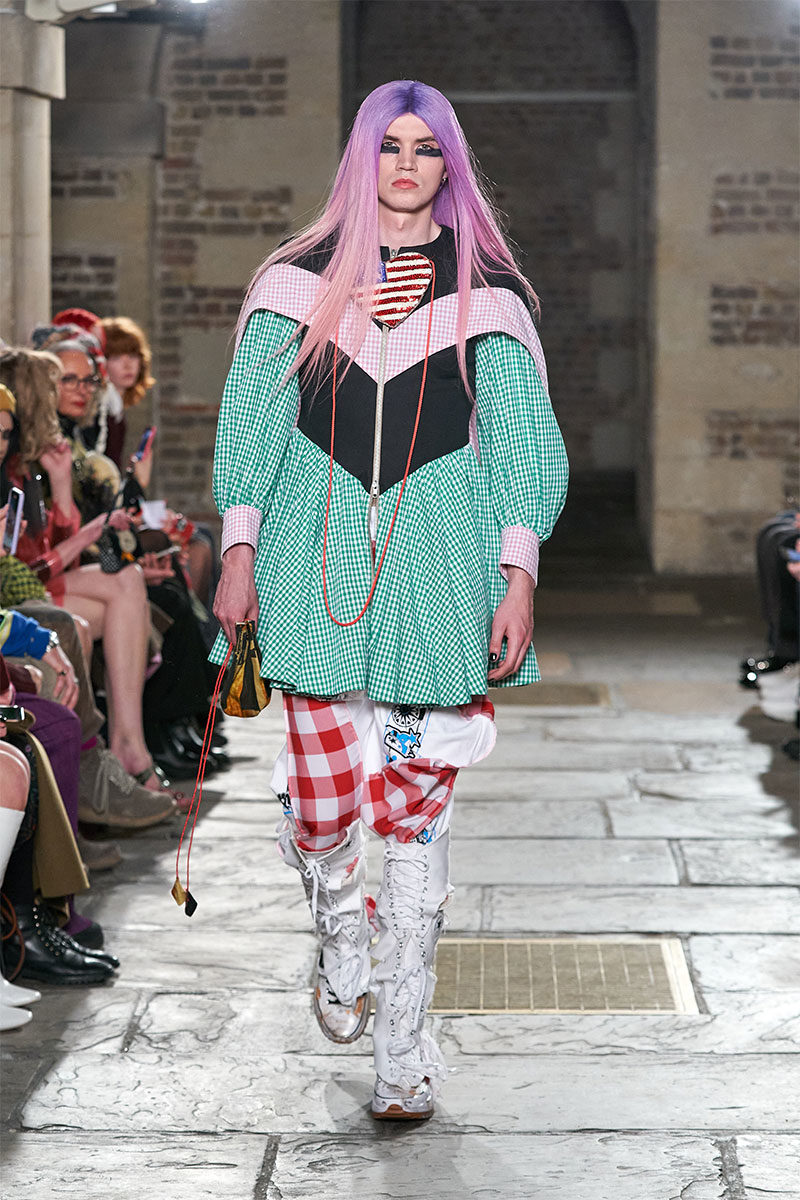As Storm Eunice blew over London today, Matty Bovan and his guests sought refuge in the crypt of St. Martin-in-the-Fields on Trafalgar Square. Aptly, he titled his collection Cyclone: a force that causes “chaos and destruction—even beauty—in the wake of its power.” He was talking about the pandemic, but you could say the same for the organised chaos that embodies his work. Some find it messy, others soulful. This season, it was punk for the globalised generations: the kids who have grown up as immersed in other cultures as in their own and feel a need to rebel against said cultures’ symbols of patriotism.
Enter America, a place—Bovan argued—that has so many cultural divisions which all lay claim to its national iconography that those symbols have become universal. “They’re very fun to subvert. Like England, they don’t really belong to anyone,” he shrugged. The Yorkshire-based designer was wearing a Carrie Bradshaw-style necklace with the name Derek on it in homage to his American musician boyfriend, who spends part of his work researching undiscovered folklore music from America. Together, they spent two months in his hometown of Bridgewater, Connecticut this season (“it’s where Mia Farrow lives”) where Bovan found inspiration for his first collection based on American culture.
How did Connecticut react to the designer’s appearance? “Well, I’m kind of used to it. But I’m not ridiculously out-there. I still wear jeans and…” he paused. “I mean, it still looks weird. But it was good. It was fun. I’ve looked at England for so long, I needed to look at something else. America is very easily parodied and there’s a lot of iconic symbols—the star, the stripe—which I like to play with.” As far as American socio-political commentary goes, his collection didn’t escape cliché territory. But that didn’t make it any less captivating. Within the ripped-up sensibility of Bovan’s work (which is often how it feels, even if it isn’t) his various treatments of the American flag—hand-painted on jeans, as a train on a jacket, as star cut-outs queerly stitched all over a dress with a naval military cape—very much read as punk.
As did a series of repurposed classics from collaborations including Vivienne Westwood, Adidas, Converse All-Star, Alpha Industries, and Calvin Klein. The feeling was echoed in the de- and reconstruction of bomber jackets and parkas—some spliced together—and a beautiful hand-painted blouson with the words “Hopeful” and “Bad Dreams” spelled out within its abstract motif. But the political element here was above all in the casting. Not in Irina Shayk, who opened the show in a repurposed Roksanda Ilincic puffball gown, but in all the bulky frames that followed. Through a conventional lens, these bodies read as masculine. Dressed in Bovan’s genderless garments, which traverse the body-conscious and the dramatically draped, they came across as an interesting comment on male roles from an American perspective.
A few weeks ago, Sean Penn incited fury when he argued that “cowardly genes… lead to people surrendering their jeans and putting on a skirt.” You wonder what he would think of Bovan’s young bodybuilder dressed in a stretch velvet body-con dress emblazoned with an all-over “faux butch” USA print, worn under a tight, deconstructed floral pioneer apron. Looks like that, and many more, definitely felt like a comment on a kind of Trumpian male ego we still sometimes see coming out of contemporary American culture, from movies to music and indeed politics. You couldn’t help but wonder if Bovan—who identifies as male and dresses like a magical folkloric creature—did have some personal experiences of the more jarring kind during his time Connecticut.
This article was originally published on Vogue.com.

1 / 10

2 / 10

3 / 10

4 / 10

5 / 10

6 / 10

7 / 10

8 / 10

9 / 10

10 / 10





